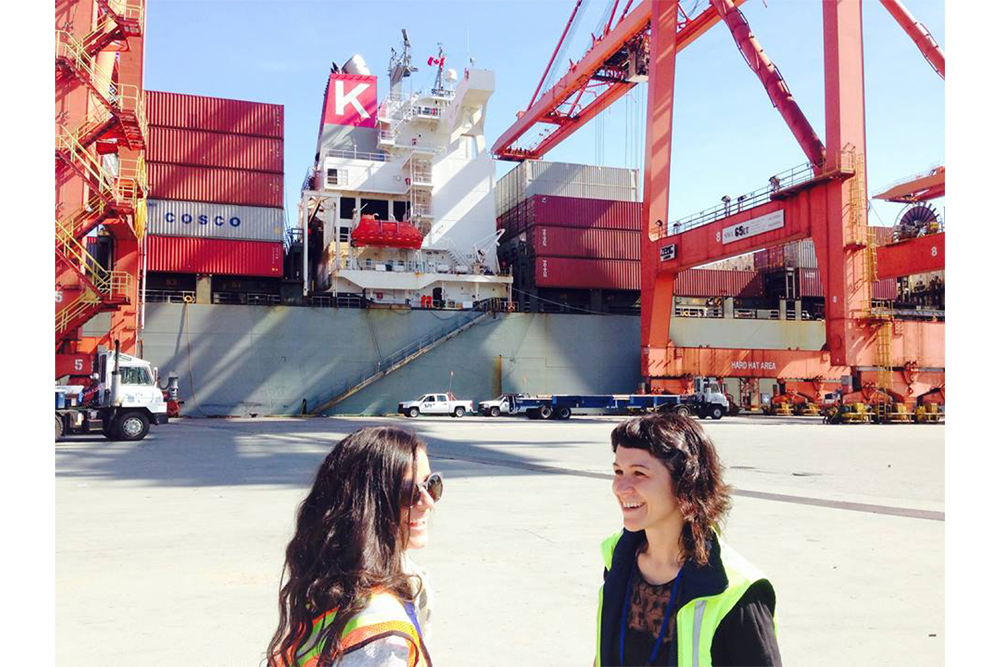It’s not unusual for artists to travel to a residency. It is, however, unusual for travelling to be the entirety of the residency.
In a slowed down, reworked version of the artworld standard, Vancouver artist-run centre Access Gallery has worked over the past year to send four artists out to sea to make work on cargo ships that are travelling across the Pacific Ocean from Vancouver to Shanghai.
The residency, Twenty-Three Days at Sea, was developed by Access Gallery’s curator Kimberly Phillips in a nod to Vancouver’s position as a port city on the edge of the Pacific.
“We forget that while the cosmopolitanism of air travel and the Internet’s supposed pervasiveness fuel the perception of instantaneous global connectivity, the vast majority of materials and commodity objects move about the world by sea, at a rate not far accelerated beyond that achieved in the first quarter of last century,” says Phillips.
The sheer imagery of the residency—artists sent off one-by-one across an ocean—also offers a tongue-in-cheek rejection of Vancouver’s inaccessible real-estate market.
“Unable to host artists on Vancouver’s terra firma for any meaningful length of time, one might say that we cast our thinking out to sea,” says Phillips.
Three artists made the trek in 2015: Vancouver-based Elisa Ferrari, Toronto and Beirut–based artist Nour Bishouty and Montreal-based artist Christopher Boyne. Melbourne artist Amaara Raheem will begin her trip in April.
Nestled into their basic cabins, the artists embark across the ocean, following the regimented structure of life aboard, with set meal times and established socializing periods. Each artist thus far has travelled on a different cargo ship: Ferrari boarded the Hanjin Ottawa; Bishouty, the Hanjin Brussels; and Boyne, the Hanjin Geneva.
And while the ships were slightly different, the experiences, by and large, were universally astounding.
“The most accurate way to describe my experience would be really a mixture of fascination and boredom and a lot of very contrasting emotions—being extremely afraid and excited,” says Bishouty, who departed in late August. “I went in knowing that it was something I won’t do again, so I was trying to absorb anything I could while I was on the ship.”
Boyne’s experience was similarly remarkable.
“It’s a funny thing to talk about because it was a very big experience,” Boyne says. “I keep trying to find a way to talk about it quickly, or on a small scale and it’s difficult. The whole experience was overwhelming. Every aspect was special.”
With different ships, each route was slightly different. Where Ferrari sent a message back to Phillips about the lack of birds out at sea, Boyne was struck by the abundance of wildlife.
“We were 19 days without seeing land, and the days were incredible,” says Boyne. “We only saw about three or four ships as we crossed the Pacific. There’s lots of water and wildlife—dolphins, whales, porpoises and birds.”
For some of the residents, the ship’s internal life—its crew and their relationships—was just as notable as the ship’s external environment. For Bishouty, in particular, the relationships with the crew were central to the outcome of her work during the residency.
“There was one person who was very interested in talking with me: the second officer, Elmar Streicher, who was German,” says Bishouty. “He told me about his work, about what he does on the ship. There were so many conversations and stories and narratives that I documented during my time on the ship, and many were conversations I had with him. He became central to my work, and his story became much more than just conversations.”
Working on a ship has its limitations, though. Without studio space (and limited living quarters), artistic production tends towards collecting. Neither Boyne nor Bishouty brought extensive materials, and both relied on a process of data collection—taking photographs, writing notes, drawing sketches and recording data. In many ways, it was a welcome change.
“I had actually gone on the residency with the intention of separating myself from the usual modes of working,” says Bishouty. “My time on the residency was, for the most part, collecting and documenting and writing and filming…. I wasn’t producing, I was absorbing, making records and archives.”
The results from all of the residencies will be on view at Access Gallery later this year from May 27 to July 16.
While floating on a cargo ship provides an escape from a certain kind of reality, it can’t insulate the passengers from all of the world’s ills. An artist who had independently completed the cross-Pacific trip in a cargo ship and witnessed intense discrimination between the German and Philippine crews approached Boyne at a talk after he had returned to land, asking if he had noticed the same tensions.
“Now I’m wondering if this racism was happening and I didn’t see it,” says Boyne. “Was I blind to it, was it hidden from me? Did I have a crew that were genuinely happy with each other?”
Few entries back into the metropolitan world could be as extreme as travelling across an isolated ocean for 23 days only to enter the intense buzz of Shanghai, which has the largest city-proper population in the world.
After its successful first iteration, the residency will be continue later in 2016—although there is stiffer competition for spots in the next round, as more than 1,000 artists have applied to participate.
But, for a once-in-a-lifetime, the residency may be worth the hurdles. As Boyne says, it’s an experience that sticks: “I feel like I’m still out there in a lot of ways.”









